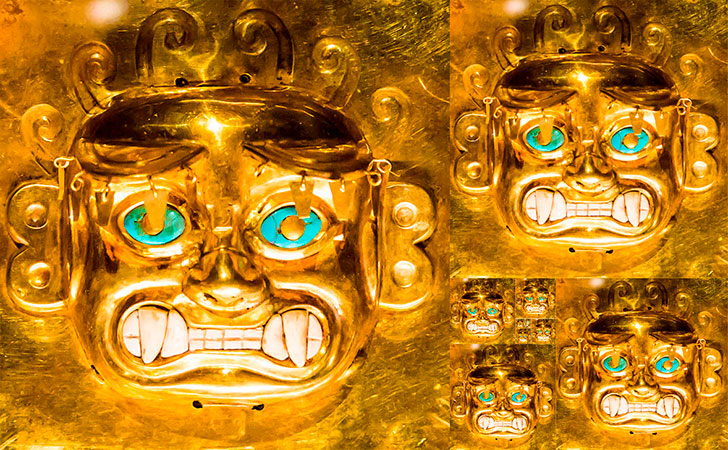|

Facial Harmony: Symphonic Geometry and the Golden Ratios in the Octopus Frontlet of Moche, Peru
Above A PRICELESS ancient Peruvian headdress dating back to AD700 has been recovered after an international operation lured the looter to Britain. The Pre-Inca Mochica or Moche civilization flourished for about 1,000 years between 200BC and AD700 on the northern coast of Peru.
Treasured
Found. Peru Gets
Pre-Inca Gold Headdress Returned
Friday September 15, 2006
Source: Guardian Unlimited
LIMA, Peru (AP) - Peru
celebrated the return Friday of a prized 1,300-year-old
embossed gold headdress looted from an ancient tomb
nearly 20 years ago. With a feline face at its center
and eight curving tentacles, the artifact - which
collectors say could be among Peru's most valuable
treasures and worth close to $2 million - was recovered
last month in a raid on a London lawyer's office.
The golden headdress was made in the image of an ancient
sea god and dates back to around 700 A.D., making it a
prized example of artwork by the Mochica civilization
that inhabited northern Peru.
It was recovered last month by Scotland Yard's Art and
Antiques squad after an undercover ``sting'' operation.
Flanked Friday by a heavily armed police detail, Foreign
Minister Jose Antonio Garcia Belaunde delivered the
headdress - looted in 1988 from a tomb in the
Jequetepeque valley in northern Peru - to the nation's
National Museum.
Looted Peru
Moche Headdress Recovered in London
August 18, 2006.
Source:
National Geographic News
A Peruvian treasure
lost for nearly 20 years has turned up in the
offices of a London law firm, local police
announced yesterday.
London's Metropolitan Police took possession of
a pre-Inca headdress—estimated to be at least
1,300 years old—made by the Moche civilization
of northern Peru. The object is due to be
returned to Peruvian authorities.
The gold artifact, which bears the image of a
feline sea god with octopuslike tentacles, had
vanished from a royal tomb in Peru in the late
1980s. It was brought to the law firm by a
client who says he did not know that it had been
stolen.
Looted Peru treasure found in UK
August 17, 2006.
Source:
BBC News
An ancient Peruvian headdress which was looted
from an archaeological site almost 20 years ago
has been found by police in London.
It is considered a national treasure and
disappeared in 1988 after a tomb in northern
Peru was raided and its contents sold on the
black market.
It was handed to a firm of solicitors in central
London by one of its clients who did not know it
was stolen.
The headdress, depicting a sea god, dates back
to 700AD.
It is an example of ancient Peruvian Mochica
civilization art and is regarded by experts as
one of the most important artifacts in Peruvian
cultural heritage.
Dr Walter Alva, director of the Royal Tombs of
Sipan Museum in Peru, described the seizure as
"a very important moment in the worldwide war
against illicit art and the looting of my
country".
"We are speaking about an archaeological object
[of] the utmost historical and aesthetic
importance, which is one of the most important
ornaments of the ancient Peruvian cultures," he
added.
It was recovered by officers from Scotland
Yard's Art and Antiquities Squad, who will now
send it back to Peru.
No-one has been arrested and the investigation
is now in the hands of the Peruvian authorities.
The investigation also drew on the expertise of
Michel Van Rijn, an art dealer with extensive
experience of hunting for illicit and stolen
works of art.
He said: "It is impossible to put a price on a
piece of history and world heritage such as this
because they never come on the market, but
should it do so, it could potentially reach in
excess of £1m."
Headdress surfaces from dark trail of deals
August 19, 2006.
Source nzherald.co.nz
 PERU
- A gold headdress, which has been described as
"Peru's Mona Lisa", has been recovered by
Scotland Yard. The headdress, which is almost 1m
wide, depicts a sea god, portrayed as an octopus
with a stylized human head. It is regarded by
experts as one of the most important artifacts
of Peruvian culture. PERU
- A gold headdress, which has been described as
"Peru's Mona Lisa", has been recovered by
Scotland Yard. The headdress, which is almost 1m
wide, depicts a sea god, portrayed as an octopus
with a stylized human head. It is regarded by
experts as one of the most important artifacts
of Peruvian culture.
The piece disappeared in 1988 shortly after it
was discovered in a tomb in northern Peru.
The headdress is believed to have ended up in
the hands of Raul Apestiguia, a Peruvian dealer
who was murdered in 1996 and his home ransacked.
It next appeared on the black market for sale by
a notorious Latin American dealer, along with
another 41 stolen artefacts. A London-based
dealer, Michel van Rijn, posted details of the
headdress on his website with details of the
alleged illegal trader. He was contacted by the
dealer, who offered the headdress in return for
taking his details off the website.
Officers from the Metropolitan Police's art and
antiques squad struck after the trader handed
the headdress to a lawyer in London for
safe-keeping. The piece was seized but the
dealer escaped.
Facts about Pre-Inca civilization: Mochica /
Moche
-
The Pre-Incas Mochica or Moche civilization
flourished for about 1,000 years between 200BC and AD700 on the
northern coast of what is now Peru. The society’s major
ceremonial and administrative site was Moche, now one of Peru’s
most monumental archeological sites.
-
Mochica tombs are filled with some
of the most proficient pottery and metalwork found in the
central Andes
-
Mochica ceramics are among the best
known of ancient Peruvian artifacts. So-called portrait-head
effigy pots are especially notable for realistically depicting
human features and portraying emotion.
-
Mochica produced more erotic pottery
than any pre-Columbian civilization.
-
Mochica metalwork was ornate and
technologically advanced. Body ornaments of gold, silver,
copper, and alloys were inlaid with turquoise and lapis lazuli.
-
They irrigated extensively, and
their agriculture supported many urban centers, which featured
stepped pyramids. The cause of their demise is unknown.
Post a comment.
|